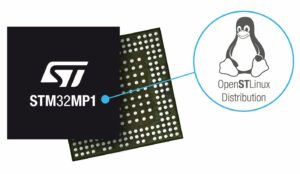To improve the accessibility of our content, please find the audio version of this blog post.
On October 21, 2020, ST will hold its first online roundtable with design houses. It’ll be a unique opportunity to have an open discussion and take attendees’ questions. The conversations will revolve around an engineer’s experience with product development for the Internet of Things and address recent challenges. The event is part of our Virtual ST Developers Conference, which will take place on October 20 and 21. The online exhibition will feature our latest demos and a chance to connect with the industry. The roundtable will host two design houses: Siana Systems and Synapse. Today’s blog post focuses on the former and its groundbreaking work with the STM32MP1.Welcome to Siana Systems
To better understand Siana, we sat down with Sylvain Bernard, its founder, and Solution Architect. He explained that his company primarily works on projects that utilize STM32 microcontrollers. As a member of the ST Partner Program, Siana works closely with ST to offer customers pertinent and modern solutions. For instance, Sylvain teamed up with our Machine Learning Group to provide systems that took advantage of STM32Cube.AI. However, Siana is also a fascinating case study in engineering because of its recent work on STM32MP1 microprocessors. Indeed, the company was one of the first to start experimenting with the MPU and OpenSTLinux. It spent considerable time researching and developing on this platform, and today, it has two new project starters: MPVoice and MPCam.
Siana: The Journey from MCU to MPU
The Learning Curve
Moving from STM32 MCUs to the STM32MP1 means learning to use the Cortex-A7 to its full potential. As Sylvain explained:
“We worked on the STM32MP1 for a year to figure out what we could do with it and how to best use its capabilities. Mastering Yocto is also another crucial skill that may have a steep learning curve. However, ST made the right move to partner with the Yocto Project. Without it, or something similar, embedded Linux is simply far too limited.At the end of the journey, Siana came out with reference designs that they still use today. Hence, taking the time to know the hardware is crucial and rewarding. Unlike microcontrollers that tend to have a more straightforward architecture, microprocessors are more complex. Similarly, using a real-time operating system is less complicated than running embedded Linux. However, as Siana also shows, mastering these challenges yields great returns.
The Return on Investments

Working with an MPU and embedded Linux means that engineers have access to a lot more software. When using an RTOS, developers must customize significant aspects of their application. Frameworks are also sparse or even non-existent, like an HTTP2 stack. On the other hand, working on embedded Linux means that a lot of open-source software is already available. Whether engineers are looking to use a neural network algorithm or connect to a cloud infrastructure, alternatives abound.
Similarly, there are quite a few frameworks and plenty of hardware resources to run a GUI compared to an MCU. Siana shared that taking the time to master the STM32MP1 opened them to writing new applications faster. Indeed, it meant their teams could easily use a vast number of open-source software and benefit from the broad Linux community.
How Does Siana Figure Out Where the Puck Is Going?
If every engineering team goes through research and development, Siana was adamant about the importance of direction. As Sylvain told us, it is crucial to listen to markets. Without a clear vision, designers may experience discouragement and disappointments. Mastering a new hardware architecture is far from evident and doing it without an ultimate purpose makes it even harder. Siana’s goal was to work on the STM32MP1 to offer, among other things, natural language application and personal assistants. Many of their customers were looking to implement these types of solutions, but there were no viable reference designs. They, therefore, worked on the STM32MP1 with the express goal of meeting their customer’s needs and offering groundbreaking innovations.
Siana: The Path From MPU to MPVoice and MPCam
MPVoice
Siana first demonstrated MPVoice at CES 2020. The platform serves as a complement to ST Voice Solution (STVS). STVS runs on microcontrollers and implements the new Alexa Voice Service Integration for AWS IoT Core. MPVoice is thus unique because it implements the traditional AVS stack on microprocessors. Siana’s engineers are also familiar with STVS and create custom solutions around it. As Sylvain shared,
“Our long-term strategy is to make ST Voice Solution a major part of our operations. Whether it is the applicative layer or hardware development, ST Voice Solution is a new driving force. We worked closely with ST on STVS and MPVoice. Siana’s next step is to offer a custom reference design for MPUs that doesn’t rely on Amazon’s service.”
MPCam
MPCam is the other major project from Siana that utilizes an STM32MP1. It is a smart camera module that can run a neural network for image recognition. The system uses a framework that facilitates artificial intelligence at the edge. Sylvain gave us additional insights behind the product. As he told us,
“Computer vision usually runs on a PC with many cores because the application is resource-intensive. Being able to run a decent algorithm while keeping the bill of materials down was, therefore, a challenge. MPCam thus represents a unique solution to this engineering problem. The STM32MP1 helps Siana keep costs reasonable while offering interesting capabilities.”The next step for the design house is to offer Yocto images running other frameworks like TensorFlow. Ultimately, Siana also explained their approach to engineering challenges. Too often, teams build for the best systems possible, then try to shrink their application to meet cost constraints. Siana adopts a different approach. Instead, its engineers start with more resource-constrained systems and see what problems they can solve.
Any Final Advice Before the ST Developers Conference Roundtable?
An advice Sylvain would give to engineers working on an STM32MP1 would be to appreciate its Cortex-M4. Too often, engineers underestimate its potential. For instance, being able to load a firmware from the Cortex-A7 to the Cortex-M4 offers unique possibilities. Engineers can also use System-in-Package devices, like those from Octavo, to accelerate developments or deal with low volumes. Ultimately, engineers ought to focus on the MPU’s ability to keep costs down when working on product designs.
- Discover Siana Systems
- Register for the Roundtable
- Attend the Virtual ST Developers Conference
- Learn more about the STM32MP1
